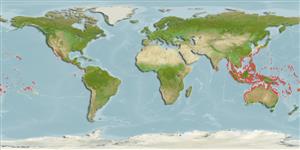Common names from other countries
Environment: milieu / climate zone / depth range / distribution range
Ecologia
; estuarina. Tropical
Indo-Pacific.
Length at first maturity / Tamanho / Peso / Idade
Maturity: Lm ? range ? - ? cm Max length : 3.5 cm SHL macho/indeterminado; (Ref. 349); common length : 2.5 cm SHL macho/indeterminado; (Ref. 349)
This species is used as food and the shell is collected for its conspicuously striped colour (Ref. 349). Also found in running freshwater (Ref. 75835).
Life cycle and mating behavior
Maturidade | Reprodução | Desova | Ovos | Fecundidade | Larvas
Members of the order Neritopsina are mostly gonochoric and broadcast spawners. Life cycle: Embryos develop into planktonic trocophore larvae and later into juvenile veligers before becoming fully grown adults.
Poutiers, J.M. 1998. (Ref. 349)
Status na Lista Vermelha da IUCN (Ref. 130435)
Status no CITES (Ref. 108899)
Not Evaluated
Not Evaluated
Perigo para os humanos
Harmless
Uso pelos humanos
Pescarias: espécies comerciais
| FishSource |
Ferramentas
Mais informação
Idade/TamanhoCrescimentoComprimento-pesoComprimento-comprimentoMorfologiaLarvasAbundância
Fontes da internet
Estimates based on models
Preferred temperature
(Ref.
115969): 27.4 - 29.3, mean 28.7 (based on 1677 cells).
Vulnerabilidade
Low vulnerability (10 of 100).
Categoria de preço
Unknown.
